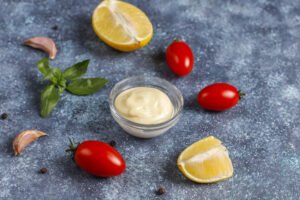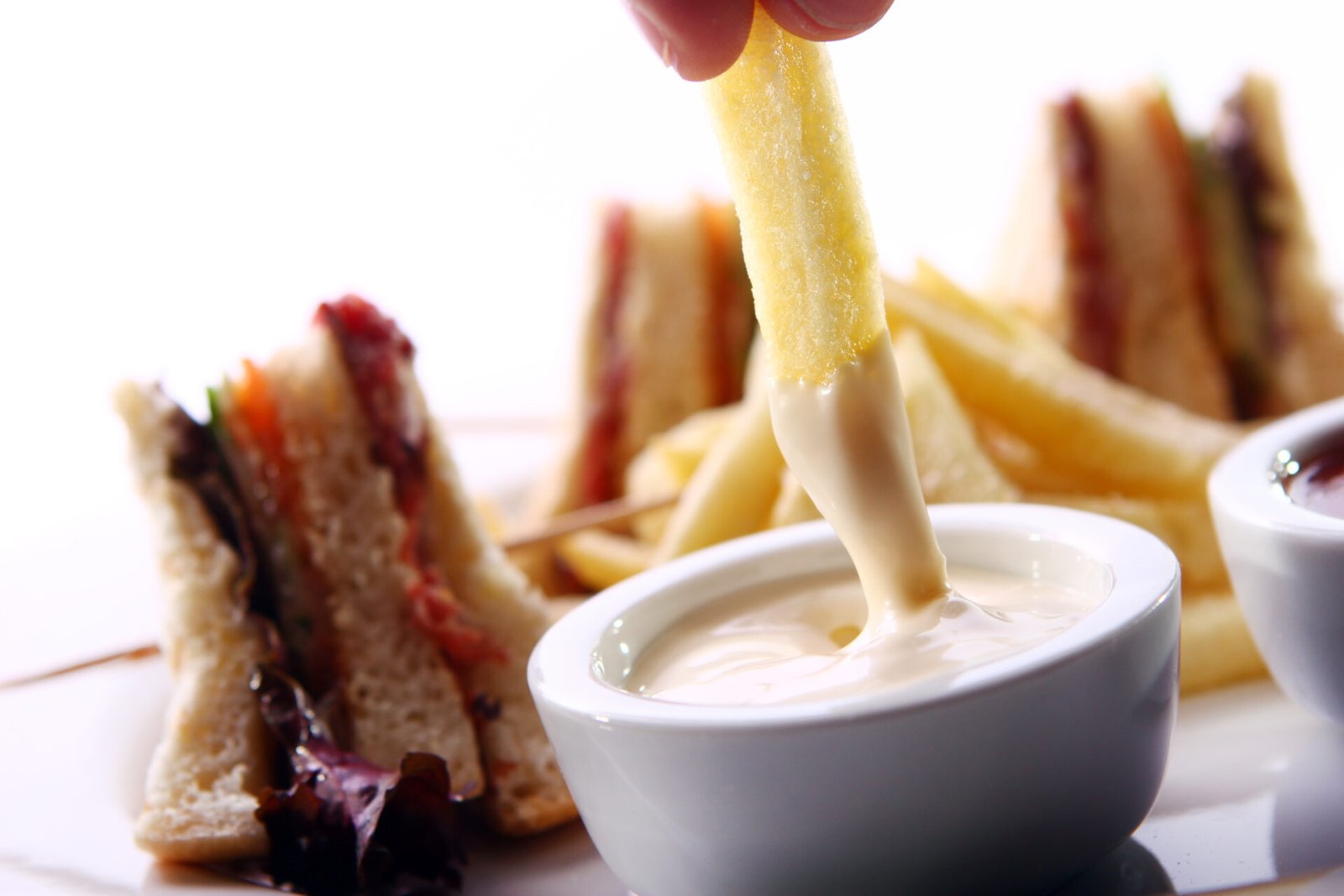Mayonnaise Sauce

Mayonnaise sauce is an easy, make-from-scratch recipe that results in a creamy and versatile sauce. Here is a detailed recipe for you:
Ingredients:
– 1 large egg yolk, at room temperature
– 1 teaspoon Dijon mustard
– 1 tablespoon lemon juice or white vinegar
– 1 cup vegetable oil or light olive oil
– Salt, to taste
– Optional: additional flavorings like minced garlic, herbs, or spices
Equipment:
– Mixing bowl
– Whisk or electric hand mixer
– Measuring spoons
– Graduated liquid measuring cup
– Slow drizzle tool (like a squeeze bottle or small measuring cup with a spout)
Instructions:
1. Prepare Ingredients: It is also recommended that the egg yolk be brought to room temperature before incorporating into the recipe. This way, it emulsifies with the oil, once the ingredients have been mixed up together together easily. Take equal measures of the other ingredients, for instance, flour, baking powder, cinnamon, salt, Stayman wine, citrus fruits and nuts.
2. Whisk Egg Yolk and Mustard: In mixing bowl, beat the egg yolk with the Dijon mustard, while making sure that the two have been melded together well. This mixture will serve as the foundation from whence the mayonnaise will spring.
3. Add Acid: Slowly work in the lemon juice or vinegar into the egg yolk by constantly stirring it. By the way, it plays a role in stabilizing an emulsion and brings more taste.
4. Slowly Incorporate Oil: As the whisking is in progress, slowly and steadily pour down the vegetable oil or the light grade olive oil in a steady thin stream. One must ensure that the oil is incorporated slowly in order to ensure that it mixes right with the egg mixture. The slow drizzle can be accomplished using a squeeze bottle or a measuring cup that has been shaped at the edge to allow for a slow discharge of liquid.
5. Continue Whisking: Whisk rapidly and continue adding the oil until they are well blended, and the mayonnaise is thick as you want it to be. Thus, it should be thick and creamy to achieve the appropriate texture in the finished product.
6. Season: After the mayonnaise is properly emulsified, it’s time to season with salt, to your preference. You may also put other additives such as minced garlic to it, or any herbs or spices of your preference at this creamery stage.
7. Adjust Consistency (Optional): Coating on the thicker sides, you can add a small portion of water or lemon juice and mix to achieve the desired thickness of the mayonnaise.
8. Store: Scrape the mayonnaise sauce into a sterilized jar and chill it up until it is needed. Mayonnaise made at home should be eaten soon because it is likely to spoil after a week of being stored in the refrigerator.
Tips:
– Make sure to have the best quality of ingredients as well as the freshest one to make the dish taste good and has the right texture.
– Ensure that you add the oil slowly and that you whisk at the same time for the best results so that the oil and soup can mix properly.
– If the mayonnaise splits or is too thin, you can try to fix it by whisking in extra egg yolk or adding a little mustard to help emulsify it again.
– Experiment with different flavors and spices to customize the mayonnaise.
Homemade mayonnaise is perfect for spreading on sandwiches, adding to fries, or as a base in creamy dressings and sauces. Enjoy your sweet creations!
Calories in Mayonnaise Sauce
Mayonnaise sauce has a rich history and comes with many benefits. Let’s take a closer look at both:
history:
1. Origins: Mayonnaise sauce is believed to have originated in the 18th century during the Seven Years War in Mahon, Menorca, Spain. This dish is said to have been brought back to France by the Duke of Richelieu, a French captor of Mahon. However, the exact origin of mayonnaise is still debated.
2. French takeover: Mayonnaise became popular in France, especially after the French military leader Duke of Richelieu’s chef introduced it to French cuisine, the French modified the sauce and popularized it, making it widely used in In French cooking.
3. Global expansion: Mayonnaise eventually spread to Europe and other parts of the world, becoming an ingredient in many desserts. Its popularity peaked in early 20th century America, where it became a staple in dishes like potato salad, coleslaw and sandwiches.
Benefits:1. Versatility: Mayonnaise sauce is incredibly versatile and can be used in a variety of dishes including sandwiches, salads, dressings, dips and sauces. Its creamy texture and tangy flavor enhance the flavors of many dishes.
2. Healthy fats: Mayonnaise is made primarily from oil, which provides healthy fats, such as monounsaturated and polyunsaturated fats. These fats are beneficial for heart health and can help reduce the risk of heart disease when consumed in moderation.
3. Vitamin E Source: Mayonnaise contains vitamin E, a powerful antioxidant that helps protect cells from free radicals. Vitamin E also plays a role in immune function and skin health.
4. Provides creaminess without dairy: Mayonnaise is popular with people following a dairy-free or lactose-free diet because it provides creaminess without the use of dairy and is often used as an alternative to dairy products is a food substitute.
5. Convenient and shelf-stable: Store-bought mayonnaise is readily available in supermarkets and lasts longer if stored properly in the refrigerator This ingredient makes it the pantry key it is easy to add flavor and texture to food.
6. Customizable: Homemade mayonnaise offers customization by changing ingredients and flavors to suit individual preferences. You can experiment with different oils, vinegars, mustard and spices to make different types of mayonnaise.
7. Easy to make: While commercial mayonnaise is everywhere, homemade mayonnaise is easy to make with just a few ingredients. Making mayonnaise allows you to control the quality of ingredients and avoid the additives and preservatives found in some store-bought varieties

2 thoughts on “Mayonnaise Sauce 2024”
Comments are closed.